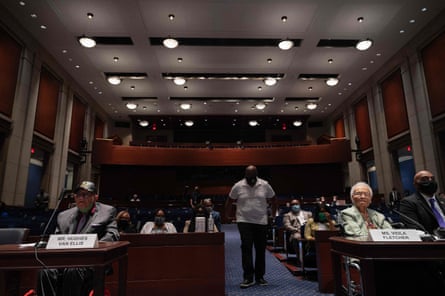
‘This is from my Fake Holidays eries, taken at the Kremlin Palace hotel in Turkey. I found an entertainer dressed as Superman and asked him to pose by the pool. You’d end up in prison if you did this in the real Red Square’
THEGUARDIAN
Wed 31 May 2023
This photo is part of my Fake Holidays series. At the beginning of the project, more than 15 years ago, I went to Lara Beach in Antalya, Turkey, where there is one luxury five-star hotel after another, all along the coastline. On the other side of the road were the tents of the workers who had built the hotels. Luxury hotels are like little ghettoes. You take your plane and your taxi, then you are in the middle of an isolated luxury area.
The Kremlin Palace hotel, where this photo was taken, has an exact copy of Saint Basil’s Cathedral in Red Square, Moscow. I have been to Moscow and seen the original church, which is a focal point – all tourists take a picture there. But here in Turkey, there is a swimming pool in front of the cathedral. I was fascinated. There were many Russian tourists.
I saw a weird guy, an astronaut, walking around the pool. “What’s happening here?” I asked. It turned out the hotel had a huge room with costumes for the entertainers who perform for the tourists. Superman was one of them. I found him by the pool and immediately asked to take his picture. I took about three shots. I chose the photo point, in front of the church with the pool between us, then asked Superman to jump. It was a very childish approach, perhaps, but he did it. The way he jumped was perfect. I felt in the moment: “That’s the picture.”
There is an entire industry manipulating us through our surroundings
It quite often happens that when I take a picture, I know it’s strong, but when I go home and look more closely, I understand its more complex meaning. This was one of those times. When I saw the image on my computer screen, I understood what it was about. There is the No 1 tourist site in Moscow, which stands for the entire history of the Russian empire, and then you have Superman on that famous square, jumping over Saint Basil’s Cathedral. It is Superman, representing American power, rising above what represents the Russian empire.
It would have been impossible to take a photo like this in the real Red Square and, now, I think you would end up in prison. In 2006, it was more simply a funny image: the collision of two worlds in one picture. The Crimean crisis happened much later, in 2014, and we were a long way away from the Ukraine conflict. If I look at the picture now it has a different meaning: I relate it to the political situation nowadays and it is getting more and more interesting. I loved the image before, but some images take their time to develop their whole impact.
My Fake Holidays project was inspired by seeing how many European cities were creating artificial beaches. I first came across one in Hamburg, Germany; they had put sand on the street and set up palm trees, and there was an inflatable swimming pool. I took off my shoes and put my feet into the sand. I felt immediately transported – just touching the sand reminded me of beach holidays when I was a child. I was fascinated by the idea that we can be so easily manipulated by our surroundings. There’s a whole industry doing it, like Disney – the mother of all leisure parks. I took photographs all over Europe, China, the United States, Japan … I was fascinated by the facades of happiness.
In my heart, I still feel like a documentary photographer. I am reflecting what I see with my photographs. The representation of reality with photography is a beautiful idea, but photography is changing a lot these days. We have artificial intelligence. Last month, an AI image was selected for the first time for a photo contest. But the most beautiful thing with photography is that reality is so strong. If you go out for a walk with a camera, you can’t imagine what you will find until you find it.

Reiner Riedler’s CV
Born: Gmunden, Austria, 1968.
Trained: Photography at Höhere Graphische Bundes-Lehr und Berufsanstalt, Vienna.
Influences: “Taryn Simon, Paul Graham, Wolfgang Tillmans.”
High point: “In the pandemic, I had a lot of time to think about my work. When I received a substantial grant for a film project, it was a very special moment because it marked the beginning of a new creative era for me: a step from photography to the moving image. I love these moments that give a new direction out of nowhere.”
Low point: “Being completely broke and hungry at the beginning of my studies.”
Top tip: “I believe in the importance of documenting. Photography doesn’t have to submit to trends.”
Reiner Riedler’s work is part of Civilization: The Way We Live Now, Saatchi Gallery, London, from 2 June to 17 September. For more of Reiner’s work, see www.photography.at and Instagram @riedlerreiner




















.jpg)

